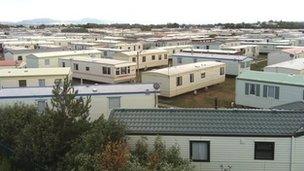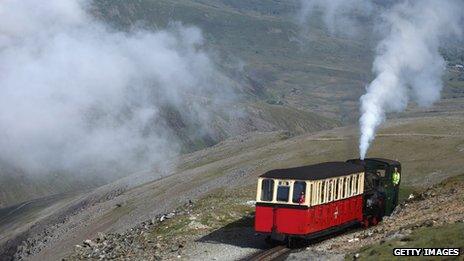Heatwave helps boost some Wales tourist destinations
- Published

The hot weather has been good news for many camping and caravan sites
Soaring summer temperatures have given a big shot in the arm to many parts of the tourist industry in Wales, early reports suggest.
Tourist numbers at some of Wales' favourite destinations surged after some of the best July weather in years.
Many camping and caravan sites also reported big increases in visitors.
However, it has not been good news for everybody. Visitors dropped in some areas and some self-catering operators said it had been the hardest year ever.
A Visit Wales spokesperson said the hot, sunny July "was a good boost for the tourism industry in Wales" and said businesses "have been reporting that the weather had a positive impact on business with late availability deals being snapped up and day trippers out in force to make the most of the sunshine".
The Camping and Caravan Club saw a 38% rise in bookings at member sites in Wales last month.
After successive wet summers, the organisation said July's heatwave brought "holidaymakers out in their thousands".
'Just passing through'
Spokesman Jon Dale added: "To date, we have seen a significant rise in the number of bookings on our club sites in Wales.
"In fact, in July, we saw a 38% increase compared to 2012 and we only expect this positive trend to continue."
Adrian Greason-Walker, executive director of Wales Tourism Alliance, said camp sites and caravan parks in well-known areas continued to be busy.
He added: "There are other places that, quite frankly, aren't doing well.
"Self-catering hasn't done very well, and we're not quite sure why.
"Some hotels are doing well - particularly in the coastal areas - but further inland it looks like people are just passing through some areas to get to the coast.
"Secondary spend seems to be down. I have heard from hotels and caravan sites that people aren't spending as much when they get there. That might be to do with the economy."
Rachel Thomas, of Coast and Country Holidays - which rents out holiday cottages - said 2013 was currently "on a par" with last year and said many people in the self-catering industry were complaining about the issue.
She said: "This is the hardest year we've had."

Some visitors flocked to the beaches rather than mountains like Snowdon
Ms Thomas said she blamed successive bad summers, and people waiting to see what the weather is like rather than booking in advance.
She said people were "still coming on holiday," but they are making their decisions late.
Asked whether she thought self-catering holiday cottage owners were pricing themselves out of the market, she said: "Some self-catering properties are cheaper than some caravans."
Roger Burgess, chair of the Wales Association of Self-catering Operators, said some of his members had been letting properties for up to 40 years, and believe business has "never been as bad".
Although there has been a recent increase in late bookings, he said this year was possibly worse than the washed-out 2012.
Mr Burgess - who rents out a property in Ceredigion - said a number of factors could be to blame, including the price of fuel.
"The one trend we can identify is a significant increase in bookings from the south Wales area, and not so many from further afield.
"I think it's mainly down to the levels of disposable income," he said.
If the trend continues, he believes some property owners may "call it a day" and stop renting out holiday homes He thinks more needs to be done to market the industry within Wales.
In some areas, like parts of Gwynedd and Pembrokeshire, he said there is a "over-supply of self-catering properties", with some second home owners now choosing to rent them out because of the economic climate.
John Griffiths, Minister for Culture and Sport, said there had been a 10% increase in visitors to sites run by historical monuments agency Cadw in July, compared to 2012.
He added: "What's more, the visitors are spending longer at Cadw sites, as a result of improved on-site interpretation, the programme of summer events, and new and engaging materials designed for families at the monuments."

Coastal areas are said to have enjoyed a boost in visitor numbers
A spokesman for National Trust Wales said it saw a 20% increase in people using its website in June, compared to the previous year. The figure for July rose by 34%.
"There's hard evidence the number of visitors to our website is the greatest it's ever been. The big spike in June and July suggests people are looking for places to go," he added.
'Bang on track'
"The past couple of years with the weather have made it very difficult to gauge what the baseline is. We'll have to wait and see whether it's a good or bad year, but the indication seems to be there's an upturn in visitors coming through the doors compared to recent years."
David Hardy, spokesman for the National Botanic Garden of Wales in Carmarthenshire, said: "We're on target for where we want to be.
"In the first fortnight of July this year, we had a 100% increase compared to last year. But that just shows you what a terrible year last year was. I can remember one day when there were 11 people here last year."
He said the run of good weather had meant the gardens were "largely bang on track" with its targets.
He added: "Late May, June and July helped make up for a what was a perishing spring. It's easy to forget that April and the beginning of May were freezing."
Snowdonia National Park Authority said there was a boost in visitor numbers at the start of July, which compensated for a wet June.
However, a spokeswoman added: "On Snowdon itself there was a small surge at the beginning of July when the good weather began, but unexpectedly the mountain wasn't as as busy as people might have expected, because we think people might have gone to the beaches."
Hot weather has also had a negative effect on some of Wales' museums.
A National Museum Wales spokesman said wet weather in June saw figures drop when compared to last year.
He added: "As visitors flocked to the coast and rural areas to enjoy the July heatwave, some of the national museums saw a drop in figures."
Figures show that St Fagans National History Museum in Cardiff saw visitor numbers drop from 86,202 in July 2012 to 59,403 last month.
Visit Wales said a new strategy had recently been launched which would see more marketing in Wales, "to retain tourism spend within Wales rather than it being lost to Wales' competitor destinations".
- Published29 July 2013
- Published19 July 2013
- Published17 June 2013
- Published21 May 2013
- Published6 April 2013
- Published23 January 2013
- Published31 August 2012